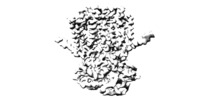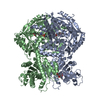+ データを開く
データを開く
- 基本情報
基本情報
| 登録情報 | データベース: EMDB / ID: EMD-9790 | |||||||||
|---|---|---|---|---|---|---|---|---|---|---|
| タイトル | Cryo-EM structure and transport mechanism of a wall teichoic acid ABC transporter | |||||||||
 マップデータ マップデータ | ||||||||||
 試料 試料 |
| |||||||||
 キーワード キーワード | ABC Transporter / TRANSPORT PROTEIN | |||||||||
| 生物種 |  Alicyclobacillus herbarius (バクテリア) Alicyclobacillus herbarius (バクテリア) | |||||||||
| 手法 | 単粒子再構成法 / クライオ電子顕微鏡法 / 解像度: 3.94 Å | |||||||||
 データ登録者 データ登録者 | Chen L / Hou WT | |||||||||
| 資金援助 |  中国, 1件 中国, 1件
| |||||||||
 引用 引用 |  ジャーナル: mBio / 年: 2020 ジャーナル: mBio / 年: 2020タイトル: Cryo-electron Microscopy Structure and Transport Mechanism of a Wall Teichoic Acid ABC Transporter. 著者: Li Chen / Wen-Tao Hou / Tao Fan / Banghui Liu / Ting Pan / Yu-Hui Li / Yong-Liang Jiang / Wen Wen / Zhi-Peng Chen / Linfeng Sun / Cong-Zhao Zhou / Yuxing Chen /  要旨: The wall teichoic acid (WTA) is a major cell wall component of Gram-positive bacteria, such as methicillin-resistant (MRSA), a common cause of fatal clinical infections in humans. Thus, the ...The wall teichoic acid (WTA) is a major cell wall component of Gram-positive bacteria, such as methicillin-resistant (MRSA), a common cause of fatal clinical infections in humans. Thus, the indispensable ABC transporter TarGH, which flips WTA from cytoplasm to extracellular space, becomes a promising target of anti-MRSA drugs. Here, we report the 3.9-Å cryo-electron microscopy (cryo-EM) structure of a 50% sequence-identical homolog of TarGH from at an ATP-free and inward-facing conformation. Structural analysis combined with activity assays enables us to clearly decode the binding site and inhibitory mechanism of the anti-MRSA inhibitor Targocil, which targets TarGH. Moreover, we propose a "crankshaft conrod" mechanism utilized by TarGH, which can be applied to similar ABC transporters that translocate a rather big substrate through relatively subtle conformational changes. These findings provide a structural basis for the rational design and optimization of antibiotics against MRSA. The wall teichoic acid (WTA) is a major component of cell wall and a pathogenic factor in methicillin-resistant (MRSA). The ABC transporter TarGH is indispensable for flipping WTA precursor from cytoplasm to the extracellular space, thus making it a promising drug target for anti-MRSA agents. The 3.9-Å cryo-EM structure of a TarGH homolog helps us to decode the binding site and inhibitory mechanism of a recently reported inhibitor, Targocil, and provides a structural platform for rational design and optimization of potential antibiotics. Moreover, we propose a "crankshaft conrod" mechanism to explain how a big substrate is translocated through subtle conformational changes of type II exporters. These findings advance our understanding of anti-MRSA drug design and ABC transporters. | |||||||||
| 履歴 |
|
- 構造の表示
構造の表示
| ムービー |
 ムービービューア ムービービューア |
|---|---|
| 構造ビューア | EMマップ:  SurfView SurfView Molmil Molmil Jmol/JSmol Jmol/JSmol |
| 添付画像 |
- ダウンロードとリンク
ダウンロードとリンク
-EMDBアーカイブ
| マップデータ |  emd_9790.map.gz emd_9790.map.gz | 28.5 MB |  EMDBマップデータ形式 EMDBマップデータ形式 | |
|---|---|---|---|---|
| ヘッダ (付随情報) |  emd-9790-v30.xml emd-9790-v30.xml emd-9790.xml emd-9790.xml | 14 KB 14 KB | 表示 表示 |  EMDBヘッダ EMDBヘッダ |
| 画像 |  emd_9790.png emd_9790.png | 61 KB | ||
| Filedesc metadata |  emd-9790.cif.gz emd-9790.cif.gz | 6.1 KB | ||
| アーカイブディレクトリ |  http://ftp.pdbj.org/pub/emdb/structures/EMD-9790 http://ftp.pdbj.org/pub/emdb/structures/EMD-9790 ftp://ftp.pdbj.org/pub/emdb/structures/EMD-9790 ftp://ftp.pdbj.org/pub/emdb/structures/EMD-9790 | HTTPS FTP |
-検証レポート
| 文書・要旨 |  emd_9790_validation.pdf.gz emd_9790_validation.pdf.gz | 555.7 KB | 表示 |  EMDB検証レポート EMDB検証レポート |
|---|---|---|---|---|
| 文書・詳細版 |  emd_9790_full_validation.pdf.gz emd_9790_full_validation.pdf.gz | 555.3 KB | 表示 | |
| XML形式データ |  emd_9790_validation.xml.gz emd_9790_validation.xml.gz | 5.6 KB | 表示 | |
| CIF形式データ |  emd_9790_validation.cif.gz emd_9790_validation.cif.gz | 6.5 KB | 表示 | |
| アーカイブディレクトリ |  https://ftp.pdbj.org/pub/emdb/validation_reports/EMD-9790 https://ftp.pdbj.org/pub/emdb/validation_reports/EMD-9790 ftp://ftp.pdbj.org/pub/emdb/validation_reports/EMD-9790 ftp://ftp.pdbj.org/pub/emdb/validation_reports/EMD-9790 | HTTPS FTP |
-関連構造データ
- リンク
リンク
| EMDBのページ |  EMDB (EBI/PDBe) / EMDB (EBI/PDBe) /  EMDataResource EMDataResource |
|---|
- マップ
マップ
| ファイル |  ダウンロード / ファイル: emd_9790.map.gz / 形式: CCP4 / 大きさ: 30.5 MB / タイプ: IMAGE STORED AS FLOATING POINT NUMBER (4 BYTES) ダウンロード / ファイル: emd_9790.map.gz / 形式: CCP4 / 大きさ: 30.5 MB / タイプ: IMAGE STORED AS FLOATING POINT NUMBER (4 BYTES) | ||||||||||||||||||||||||||||||||||||||||||||||||||||||||||||||||||||
|---|---|---|---|---|---|---|---|---|---|---|---|---|---|---|---|---|---|---|---|---|---|---|---|---|---|---|---|---|---|---|---|---|---|---|---|---|---|---|---|---|---|---|---|---|---|---|---|---|---|---|---|---|---|---|---|---|---|---|---|---|---|---|---|---|---|---|---|---|---|
| 投影像・断面図 | 画像のコントロール
画像は Spider により作成 | ||||||||||||||||||||||||||||||||||||||||||||||||||||||||||||||||||||
| ボクセルのサイズ | X=Y=Z: 1.36 Å | ||||||||||||||||||||||||||||||||||||||||||||||||||||||||||||||||||||
| 密度 |
| ||||||||||||||||||||||||||||||||||||||||||||||||||||||||||||||||||||
| 対称性 | 空間群: 1 | ||||||||||||||||||||||||||||||||||||||||||||||||||||||||||||||||||||
| 詳細 | EMDB XML:
CCP4マップ ヘッダ情報:
| ||||||||||||||||||||||||||||||||||||||||||||||||||||||||||||||||||||
-添付データ
- 試料の構成要素
試料の構成要素
-全体 : wall teichoic acid ABC transporter TarGH
| 全体 | 名称: wall teichoic acid ABC transporter TarGH |
|---|---|
| 要素 |
|
-超分子 #1: wall teichoic acid ABC transporter TarGH
| 超分子 | 名称: wall teichoic acid ABC transporter TarGH / タイプ: complex / ID: 1 / 親要素: 0 / 含まれる分子: all |
|---|---|
| 由来(天然) | 生物種:  Alicyclobacillus herbarius (バクテリア) Alicyclobacillus herbarius (バクテリア) |
-分子 #1: TarH
| 分子 | 名称: TarH / タイプ: protein_or_peptide / ID: 1 / コピー数: 2 / 光学異性体: LEVO |
|---|---|
| 由来(天然) | 生物種:  Alicyclobacillus herbarius (バクテリア) Alicyclobacillus herbarius (バクテリア) |
| 分子量 | 理論値: 30.201881 KDa |
| 組換発現 | 生物種:  |
| 配列 | 文字列: MEHAVIVENV TKKYKLFKRT SERLLDMILP GGYGEDFYAL RNVSFTADKG DVIGIVGVNG SGKSTLSNII AGILPPTSGT IKIDGQASL IAISSGLNNQ LTGRENIELK CLMLGFSKKQ IRAMEPDIIE FADIGKFIDQ PVKTYSSGMK SRLGFAISVN I DPDVLVID ...文字列: MEHAVIVENV TKKYKLFKRT SERLLDMILP GGYGEDFYAL RNVSFTADKG DVIGIVGVNG SGKSTLSNII AGILPPTSGT IKIDGQASL IAISSGLNNQ LTGRENIELK CLMLGFSKKQ IRAMEPDIIE FADIGKFIDQ PVKTYSSGMK SRLGFAISVN I DPDVLVID EALSVGDQTF ADKCLDKMNE FKERGKTIFF ISHSIGQVKS FCEKALWLEY GEVRGYGTVA EIIPQYEKFL KE YRAMSDK EKRQYKERVM RKQQGEFLQA AVK |
-分子 #2: TarG
| 分子 | 名称: TarG / タイプ: protein_or_peptide / ID: 2 / コピー数: 2 / 光学異性体: LEVO |
|---|---|
| 由来(天然) | 生物種:  Alicyclobacillus herbarius (バクテリア) Alicyclobacillus herbarius (バクテリア) |
| 分子量 | 理論値: 33.066285 KDa |
| 組換発現 | 生物種:  |
| 配列 | 文字列: MGHHHHHHHH HHMRSAVTVL MEHIRNLYLI RRLSLFELKS DNSNQYLGIL WEIINPMIQI AIYWFVFGYG IRGRHPVGHI PFILWMLAG MTVWFFVNQA VLQASKSVYT RIRMVAQMNF PISVIPTYVI TAKFYQHLML LAVIFIIFQF TPYHVSVYLV Q LPYYMFGL ...文字列: MGHHHHHHHH HHMRSAVTVL MEHIRNLYLI RRLSLFELKS DNSNQYLGIL WEIINPMIQI AIYWFVFGYG IRGRHPVGHI PFILWMLAG MTVWFFVNQA VLQASKSVYT RIRMVAQMNF PISVIPTYVI TAKFYQHLML LAVIFIIFQF TPYHVSVYLV Q LPYYMFGL LALLVSFSLI TSTLATVVRD VQMIVQSLVR ILLYLTPLLW DPSHLPHLVQ VIMRLNPLYY IVEGYRSALL GT SWYLVDH ASYTVYFWVV VILFFVFGSM VHLKFRAHFV DYM |
-実験情報
-構造解析
| 手法 | クライオ電子顕微鏡法 |
|---|---|
 解析 解析 | 単粒子再構成法 |
| 試料の集合状態 | particle |
- 試料調製
試料調製
| 濃度 | 8 mg/mL |
|---|---|
| 緩衝液 | pH: 7.5 |
| グリッド | モデル: Quantifoil R1.2/1.3 / 材質: COPPER / メッシュ: 300 / 前処理 - タイプ: PLASMA CLEANING / 前処理 - 時間: 10 sec. / 前処理 - 雰囲気: OTHER |
| 凍結 | 凍結剤: ETHANE / チャンバー内湿度: 100 % / チャンバー内温度: 281 K / 装置: FEI VITROBOT MARK IV |
- 電子顕微鏡法
電子顕微鏡法
| 顕微鏡 | FEI TITAN KRIOS |
|---|---|
| 撮影 | フィルム・検出器のモデル: GATAN K2 SUMMIT (4k x 4k) 平均電子線量: 64.0 e/Å2 |
| 電子線 | 加速電圧: 300 kV / 電子線源:  FIELD EMISSION GUN FIELD EMISSION GUN |
| 電子光学系 | 照射モード: FLOOD BEAM / 撮影モード: BRIGHT FIELD |
| 実験機器 |  モデル: Titan Krios / 画像提供: FEI Company |
+ 画像解析
画像解析
-原子モデル構築 1
| 精密化 | プロトコル: AB INITIO MODEL / 温度因子: 198.567 |
|---|---|
| 得られたモデル |  PDB-6jbh: |
 ムービー
ムービー コントローラー
コントローラー












 Z (Sec.)
Z (Sec.) Y (Row.)
Y (Row.) X (Col.)
X (Col.)





















